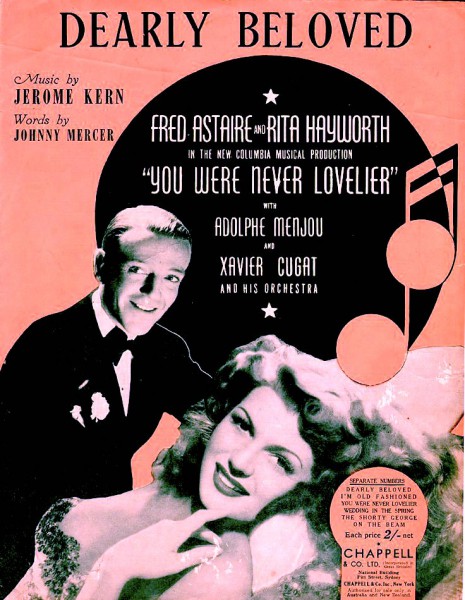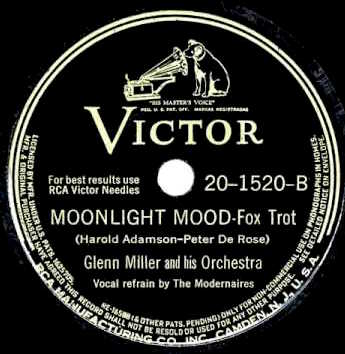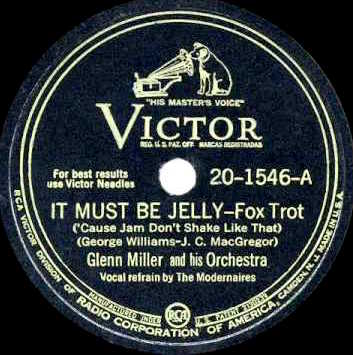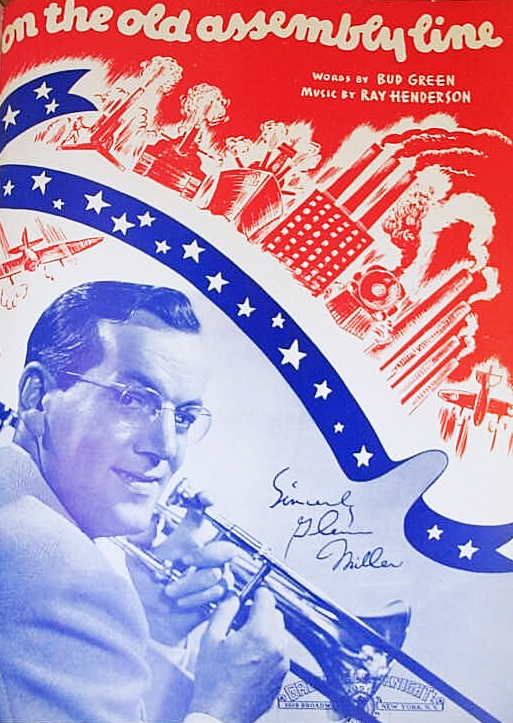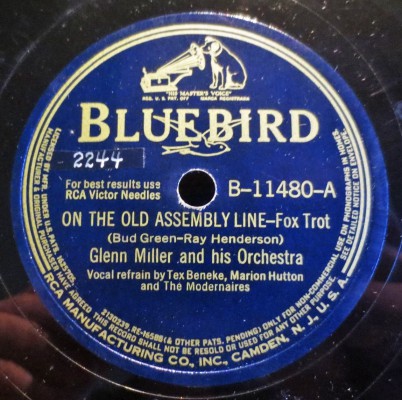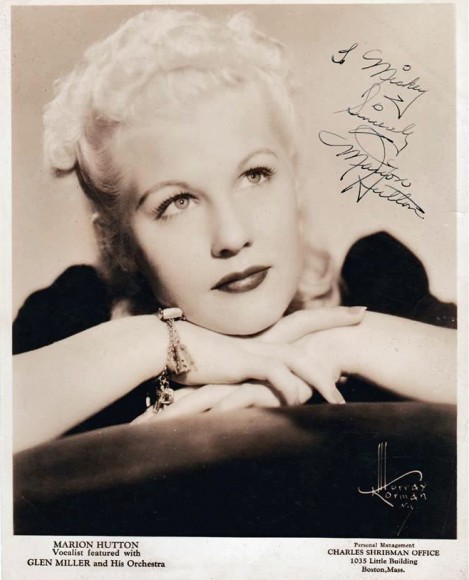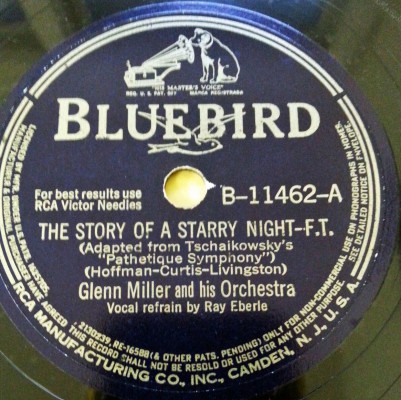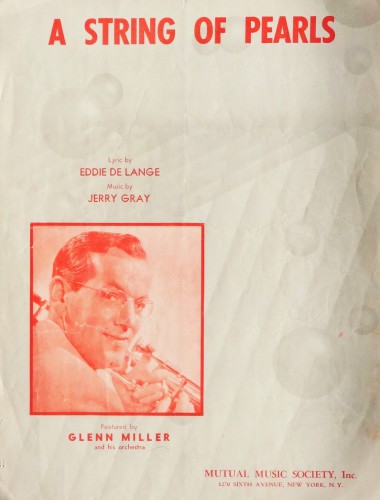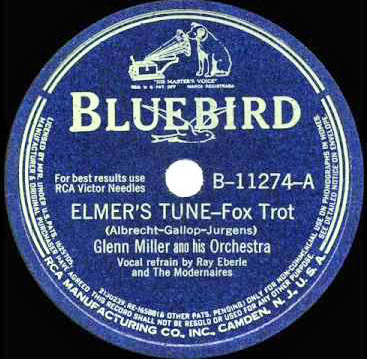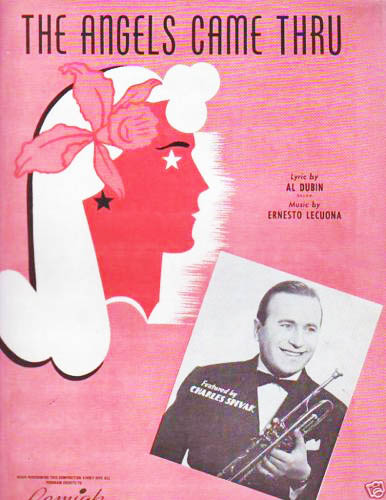Mickey McMickle, Johnny Best, Steve Lipkins, Billy May (tp); Glenn Miller, Paul Tanner, Jimmy Priddy, Frank D’Annolfo (tb); Skip Martin, Wilbur Schwartz, Ernie Caceres, Tex Beneke, Al Klink (reeds); Chummy MacGregor (p); Bobby Hackett (g & cornet); Doc Goldberg (b); Maurice Purtill (d); Marion Hutton, Ray Eberle, Tex Beneke, The Modernaires, Pat Friday, The Nicholas Brothers (vcl); Bill Finegan, Jerry Gray, Billy May, George Williams (arr).
Orchestra Wives soundtrack, 20th Century-Fox Studios, Hollywood, CA – March-April, 1942
Moonlight Serenade (film version) TCF-150
Moonlight Serenade (alternate version with harp) 20th Century Fox 100-2
People Like You and Me (MH, RE, TB & M vcl, GW and/or JG arr) TCF-127
Boom Shot (GW arr) 20th Century Fox 100-2
At Last (PF, RE vcl, JG & BF arr) TCF-129
American Patrol (JG arr) RCA LPT3065
Bugle Call Rag (GM arr) RCA LPT3065
Serenade in Blue (PF, RE & M vcl, BM & BF arr) TCF- 131/132
I’ve Got a Gal in Kalamazoo (TB, MH, M & NB vcl, JG arr) TCF-136/137/138
I’ve Got a Gal in Kalamazoo (Finale) (JG arr) TCF- 150
That’s Sabotage (MH vcl) TCF- 128
Moonlight Sonata (BF arr) LPT3065
You Say the Sweetest Things, Baby 20th Century Fox 100-2
The TCF catalog numbers are for the contemporaneous 78 and 33-1/3 pressings made by Fox for publicity/souvenir purposes. First commercial issues are RCA LPT-3065 (10” LP issued 1954) and 20th Century-Fox 100-2 (2-LP set issued 1959). All further releases stem from these albums. RCA’s transfers are clean, but Fox adds a bit of reverberation to the tracks (and more echo on later issues). RCA did not release the three numbers that premiered on the Fox LP set, as noted above. RCA also omitted this recording of AT LAST, since they issued the 1941 recording on their “Sun Valley Serenade” album. The Fox LPs only include the 1942 version, with an instrumental portion snipped out. Fox also cut the Nicholas Brothers segment of KALAMAZOO on their LPs.


Merchants will likely put their best merchandise on display up front in a store window to attract customers. The movie studios often did the same with their big band musicals – start the proceedings with a solid swing number. Ship Ahoy (Tommy Dorsey), I Dood It (Jimmy Dorsey), Private Buckaroo (Harry James), Sweet and Lowdown (Benny Goodman) and many other films began with their prime products on screen, sometimes even before the credits rolled.

Orchestra Wives followed that pattern. The film’s credits run over a lush Glenn Miller rendition of their theme song, MOONLIGHT SERENADE and the viewer is immediately presented with the band in a recording studio environment. After a brief reminder of CHATTANOOGA CHOO CHOO, the ensemble launches into PEOPLE LIKE YOU AND ME, a wonderful vocal showcase for all the band’s singers, while smooth tracking shots show off all the musicians. Marion Hutton and Ray Eberle look and sound great and the Modernaires groove along, slick and sleek behind them.

Sweet Marion & suave Ray
The guys are dressed in a variety of natty outfits, none more so that Tex Beneke, wearing a colorful Hawaiian shirt with splashy designs. Star George Montgomery mimes to Johnny Best’s hot trumpet, while Best himself sits on the other end of the section. At least Johnny got to appear in the film. Ringers Jackie Gleason and Cesar Romero mimed their parts convincingly., while Chummy Mac Gregor and Doc Goldberg sat on the sidelines. Musicians viewing the film apparently thought Montgomery fumbled his trumpet fingering and laughed out loud in theaters when the trumpet solos occurred. To this viewer, he seems competent and shows off a flashy trumpet spin at the end of his solos, which becomes his “trademark” throughout the proceedings.

“Hi there, Tex!”
A short dialogue scene following this exuberant number leads into the soda shop setting that introduces our heroine, Ann Rutherford, and her friend, Harry Morgan. She plays the fateful record of BOOM SHOT on the jukebox, precipitating a discussion of the dance where “Gene Morrison” is playing. This fades into the most striking part of the movie, likely the most haunting big band sequence in movie history. In six minutes, it captures the romance and appeal of the Swing Era to young folks everywhere.

BOOM SHOT is a very catchy Billy May original, arranged by George Williams, with solos by Johnny Best and May on open and muted trumpets, Ernie Caceres on alto and Glenn, briefly. Named after the camera crane technique that is used twice during the number, this soundtrack performance is the only one in the Miller discography and was issued on record in 1959 by 20th Century Fox. The first RCA issue of the film track in 1954 omitted it.
The restless camera swoops over, around and through the dancers who are seen happily jitterbugging, finally pulling back to catch their protests when the song ends and the band starts to take a break. Glenn/Gene signals “one more” to the crowd, which surges around the bandstand as AT LAST begins.
Though recorded and cut from SUN VALLEY SERENADE, the song was saved and, happily, found its home here. One of Mack Gordon and Harry Warren’s most notable compositions, the slowed-down Jerry Gray-Bill Finegan arrangement is much superior to the snappier-tempoed 1941 chart. It’s romantic to a fault, with brilliant passages featuring Johnny Best’s trumpet (played on screen by our hero, George Montgomery as Bill Abbott), an arresting trombone choir and plush vocals from Pat Friday (for Lynn Bari) and our own Ray Eberle. For some reason, the trombone choir moment was clipped from the 20th Fox LP and CD issues of the soundtrack.

Ann Rutherford is hooked, Harry Morgan is skeptical.
The camera roams around the band and dreamily swaying audience, poking into foliage and drawing close to the trombones (a continuous shot that must have been difficult to achieve). Without any dialogue, the plot develops, as Connie/Rutherford makes starry-eyed looks at her trumpete, which are noticed and identified by Janie/Lynn Bari, who will become her romantic rival. At the end of the song, there is a masterful shot beginning in the bell of Montgomery’s trumpet, pulling back quickly to encompass the whole scene.

After this first quarter-hour, encompassing three terrific musical numbers, the story starts rolling and we are thrust into the behind-the scenes machinations of the orchestra wives and their hapless husbands. Before that happens, the band gets another feature spot, with a partial performance of AMERICAN PATROL and a full rendition of BUGLE CALL RAG. It appears that THAT’S SABOTAGE, featuring Marion Hutton, was originally included between those two instrumentals, but was cut shortly before the film’s release. It has been part of all the film soundtrack releases on LP and CD. A brief clip from it was used in a TV documentary back in the 1970s, but the whole number has never surfaced.

A moment from THAT’S SABOTAGE.
That’s too bad, as it is a great song, smartly linking love troubles with wartime spy tactics. Marion is in fine voice and Al Klink plays a typically rhythmic solo. BUGLE CALL RAG preserves a visual record of one of the Miller band’s longest-lasting hot instrumentals, with short breaks by Miller, Beneke and Caceres and stylish choreography by the trumpets and trombones. Drummer Moe Purtill is well featured, in the spotlight for a climactic drum solo. The comic bit where he collapses into his drum kit at the end is a bit much, but it’s a good-natured moment.

Moe Purtill and BUGLE CALL RAG.
A half-hour goes by before the next Miller number, an unfortunately truncated performance of the film’s second superb ballad, SERENADE IN BLUE. The original prerecording runs nearly six minutes. In the film, the lengthy, impressionistic introduction, arranged by Billy May and Bill Finegan, along with Bobby Hackett’s first-chorus solo, were jettisoned and only Pat Friday’s vocal, backed by Eberle and the Modernaires is seen.

KALAMAZOO!
Breakups and makeups, loud arguments and apologies ensue for another half-hour. With all grievances settled, everyone gets kissy-kissy and Glenn takes center stage for a walloping finale, I’VE GOT A GAL IN KALAMAZOO. Patterned after CHATTANOOGA CHOO CHOO, the song proved to be an equally big hit, with it’s simple, catchy lyric, “A, B, C, D, E, F, G, H, I got a gal in Kalamazoo-zoo-zoo-zoo zoo…..” Marion, Tex and the Mods really shine, with all kinds of jokey posturing and kidding around, very loose and natural. Just like the CHOO CHOO, after the band portion comes the Nicholas Brothers, raising the proceedings to another level, with their sensational acrobatic steps.

The Nicholas Brothers
In a nice touch, even that is not the ending, for Moe Purtill kicks off an uptempo instrumental reprise of KALAMAZOO that allows us to get a last glimpse of the two lovebirds, Glenn and the full band. So, with the love problems settled, the musicians and their families will just go on to their next adventure on the road.

That’s also not the end of the ORCHESTRA WIVES soundtrack. Three other numbers not yet mentioned were also recorded at the time and not used. An alternate short version of MOONLIGHT SERENADE, with a harp introduction, was later issued by 20th Fox. It is slower than the performance that opens the film. MOONLIGHT SONATA, recorded back in November 1941 for Bluebird, was also redone for the film, apparently intended for Cesar Romero to mime to. Considering how badly his visual pianistics match the soundtrack already discussed, it was probably a good thing the number was cut.

Finally, YOU SAY THE SWEETEST THINGS, BABY is a real anomaly. The song, a Gordon-Warren number sung by Alice Faye in Tin Pan Alley back in 1940, is played by a small group that seems to consist of muted trumpet, two tenor saxes (one of them Beneke), piano and drums, in the first chorus. It is performed in an exaggerated, sweet style, until Billy May’s hot open trumpet blasts into the second chorus, joined by Ernie Caceres’ jazz clarinet. The two styles then battle it out to the conclusion, with May leading the way. My friend Paul Holroyd informs me that this number was intended for a cut scene where Connie & Bill take a night off to go dancing. They stop at a tea shop which has a sour little band playing and Bill can’t resist the opportunity to liven them up with his trumpet.

Since the Miller band was featured more prominently in their second film, shooting took longer then before, requiring two full months of Glenn’s time. There was a lot of catching up to do, both professionally and personally. First thing to take care of after leaving Fox was a Victor recording date, designed to wax some of the film songs for commercial release. That’s for next time.

“Zoo-zoo-zoo-zoo!”








